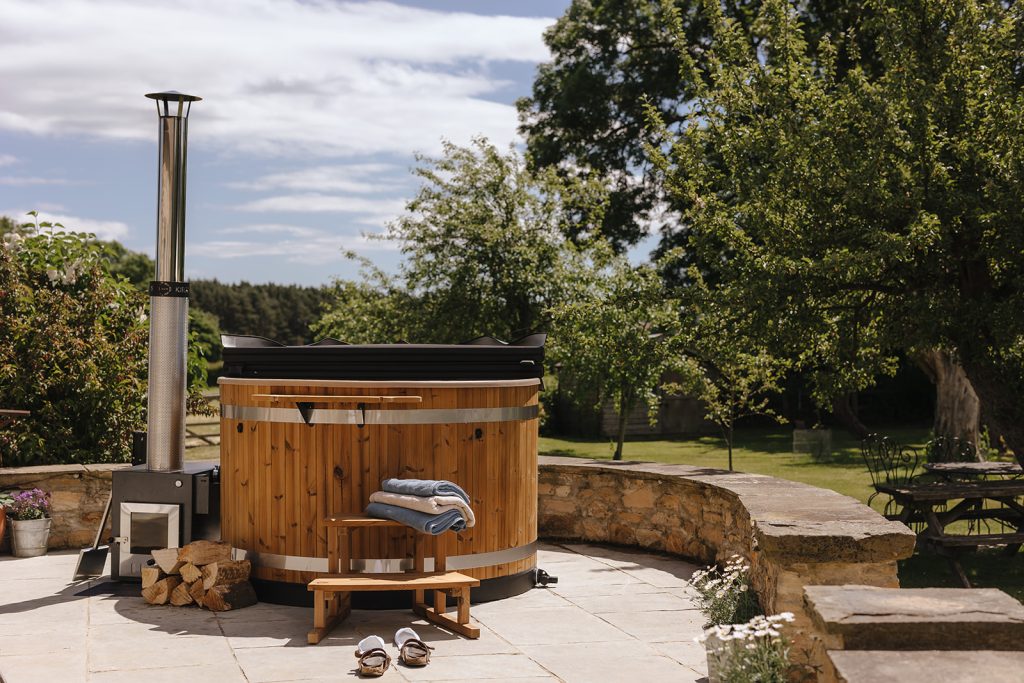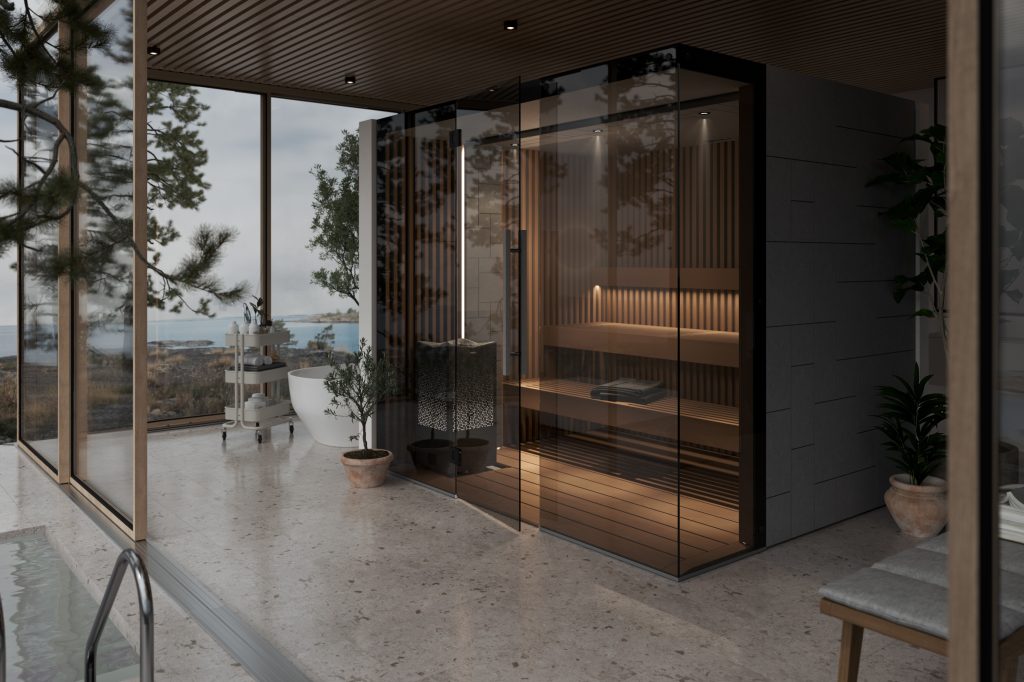Look and feel are important when making any big purchase, and part of the reason for the popularity of cedar tubs is the charming rustic look they can add to your outdoor space. But what are the options when it comes to a cedar tub? And are there any other benefits? Below, we’ll answer all the questions you may have.
Are Cedar Hot Tubs Electric or Wood-Fired?
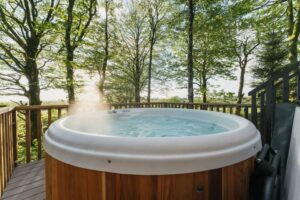 The answer is both options are available. Wooden spas are usually associated with log-burning varieties, and most spas made from cedar will fall into this category. Aside from red cedar, wood-fired hot tubs can also come in spruce, oak, larch or Thermowood – our range of Kirami wood-fired tubs, for example, are available in Finnish spruce (Original Breezy), Finnish pine (Original Tiny) and Thermowood (Comfort Family), and Kirami also offer tubs in red cedar. However, there are electric cedar tubs available – including North Star Nordic Hot Tubs and our Afon Range hot tubs, which have a cedar skirting for a beautiful natural look and feel, but feature a fully equipped electric hot tub with moulded shell, ozone and in-line sanitation, powerful hydrotherapy jets, and lighting. Our Afon Range hot tubs also come in a variety of shapes and sizes, and two finishes – cedar and charcoal.
The answer is both options are available. Wooden spas are usually associated with log-burning varieties, and most spas made from cedar will fall into this category. Aside from red cedar, wood-fired hot tubs can also come in spruce, oak, larch or Thermowood – our range of Kirami wood-fired tubs, for example, are available in Finnish spruce (Original Breezy), Finnish pine (Original Tiny) and Thermowood (Comfort Family), and Kirami also offer tubs in red cedar. However, there are electric cedar tubs available – including North Star Nordic Hot Tubs and our Afon Range hot tubs, which have a cedar skirting for a beautiful natural look and feel, but feature a fully equipped electric hot tub with moulded shell, ozone and in-line sanitation, powerful hydrotherapy jets, and lighting. Our Afon Range hot tubs also come in a variety of shapes and sizes, and two finishes – cedar and charcoal.
Do Cedar Hot Tubs Have Jets?
A cedar hot tub just describes the cabinet or skirting, so your cedar hot tub may or may not come with jets, depending on how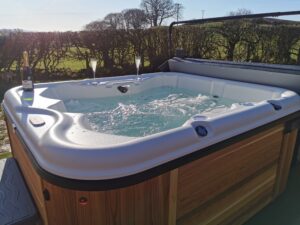 it’s powered. If you opt for a cedar wood-fired spa, for example, then most won’t come with jets (although certain brands give the option to have these fitted, at which point you will also need an electricity source to run them). If you go for an electric hot tub with cedar skirting, such as those in our Afon Range, then they will most likely come with jets. Our Afon Range hot tubs feature jets that offer a powerful hydrotherapy massage, so you get the best of both worlds – the natural look and feel of a cedar tub with the power and hydrotherapy benefits of an electric tub.
it’s powered. If you opt for a cedar wood-fired spa, for example, then most won’t come with jets (although certain brands give the option to have these fitted, at which point you will also need an electricity source to run them). If you go for an electric hot tub with cedar skirting, such as those in our Afon Range, then they will most likely come with jets. Our Afon Range hot tubs feature jets that offer a powerful hydrotherapy massage, so you get the best of both worlds – the natural look and feel of a cedar tub with the power and hydrotherapy benefits of an electric tub.
Do Cedar Hot Tubs Need Chemicals?
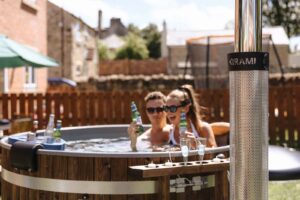 Again, if the cedar tub you have your eye on is a wood-fired tub, then no. This can save on chemical costs, but the trade-off is it’s less convenient, as the water needs to be changed very frequently – after every two to three uses at a minimum. Electric hot tubs, whether they have a cedar skirting or otherwise, will need properly balanced chemicals to ensure clear water and appropriate hygiene. On the plus side, this means you can change the water far less frequently – generally between every one to three months – meaning your hot tub is ready to use with very little waiting time.
Again, if the cedar tub you have your eye on is a wood-fired tub, then no. This can save on chemical costs, but the trade-off is it’s less convenient, as the water needs to be changed very frequently – after every two to three uses at a minimum. Electric hot tubs, whether they have a cedar skirting or otherwise, will need properly balanced chemicals to ensure clear water and appropriate hygiene. On the plus side, this means you can change the water far less frequently – generally between every one to three months – meaning your hot tub is ready to use with very little waiting time.
How Do Cedar Hot Tubs Work?
For log-fired hot tubs, you simply fill with water, and light the built-in stove to heat it to the desired temperature. This can take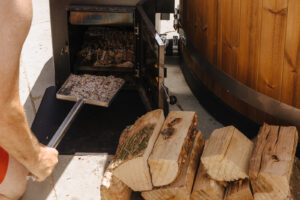 some time, so it requires a bit more patience than with an electric hot tub. Because there are no chemicals involved, the water needs changing more frequently – ideally, after every two to three uses. Electric hot tubs (whether they have a cedar skirting or other cabinet), can keep the same water for much longer – on average, this needs to be changed every one to three months, depending on how frequently you use the tub. Most modern hot tubs have automatic filtration cycles, and it’s advised to keep the tub full and covered at a set temperature, so it’s read to use with minimal wait. The water needs to be tested regularly and the chemicals balanced accordingly to keep the water clean and safe. For full details on caring for your hot tub, see our maintenance guide. If you need more information on your specific hot tub brand – either wood-fired Kirami or any of our electric hot tubs, then you can find all of our hot tub and swim spa owner’s manuals here too.
some time, so it requires a bit more patience than with an electric hot tub. Because there are no chemicals involved, the water needs changing more frequently – ideally, after every two to three uses. Electric hot tubs (whether they have a cedar skirting or other cabinet), can keep the same water for much longer – on average, this needs to be changed every one to three months, depending on how frequently you use the tub. Most modern hot tubs have automatic filtration cycles, and it’s advised to keep the tub full and covered at a set temperature, so it’s read to use with minimal wait. The water needs to be tested regularly and the chemicals balanced accordingly to keep the water clean and safe. For full details on caring for your hot tub, see our maintenance guide. If you need more information on your specific hot tub brand – either wood-fired Kirami or any of our electric hot tubs, then you can find all of our hot tub and swim spa owner’s manuals here too.
How Long Do Cedar Hot Tubs Last?
Red cedar has natural wood oils that offer protection against decay, making it a popular wood for hot tubs. However, when it comes to exactly how long a cedar hot tub will last, opinions vary wildly – some claiming ten to 15 years, others 20 to 30, and some even touting 50 or more as possible lifetimes. The truth is, the life of a hot tub – cedar or otherwise – depends on a variety of factors. Some you’ll have control over, such as ensuring your hot tub is installed on a firm, flat solid base to evenly distribute weight and reduce the instance of leaks; others, such as climate, are things you won’t be able to change.
The element you have the most control over, and one that will have one of the biggest impacts, is how you look after and maintain your hot tub. If you want yours to go the distance, be sure to get into a good maintenance routine, based on the manufacturer’s recommendations. Check your hot tub regularly for any leaks or cracks, and treat the outside of the cedar with Tung Oil (every three months, if possible). The inside of the tub shouldn’t be treated. If yours is a wood-fired tub, empty the water regularly (after every two to three uses) and clean the tub with gentle, natural cleaners as recommended by the manufacturer to stop any build up of dirt. As your cedar hot tub ages, the wood may change to a silver colour, this is a natural occurrence and doesn’t indicate damage. If your cedar tub is electric, then be sure to conduct regular maintenance and servicing. If in doubt, see the owner’s manual for tailored advice on care for your hot tub.
Cedar Hot Tub Benefits
Whatever style of cedar (or other material) hot tub you choose, there are numerous health and wellness benefits. For both electric and wood-fired hot tubs, these include reduced stress, improved sleep, better muscle recovery and a relief from aches and pains. The addition of jets in an electric hot tub also adds a powerful hydrotherapy massage that can ease muscle tension and other aches. In terms of practical/aesthetic benefits, wood-fired hot tubs won’t add to your electricity bills (although you will need to buy logs), and also have a natural look and feel. In some cases, they can be more sustainable. For electric cedar-skirted spas, they are more convenient to use, heating more quickly and requiring far less-frequent water changes. The cedar skirting on the likes of our Afon Range can provide a similarly appealing natural look and feel to a wood-fired tub. if you run a holiday let, and are looking for the aesthetic appeal of a cedar tub, then the Afon Range are also fully HSG282 compliant (more on that below).
Are Cedar Hot Tubs Suitable for Holiday Lets?
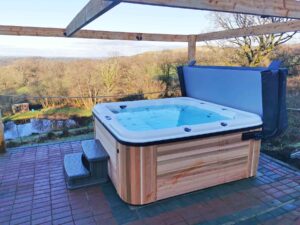 If it’s an electric cedar-skirted tub, then the answer is yes – in fact, our Afon Range tubs have been created specifically for the holiday let market. Not only do they offer the rustic cedar look and feel, but they feature in-line sanitation, come at an affordable price, and are fully HSG282 compliant.
If it’s an electric cedar-skirted tub, then the answer is yes – in fact, our Afon Range tubs have been created specifically for the holiday let market. Not only do they offer the rustic cedar look and feel, but they feature in-line sanitation, come at an affordable price, and are fully HSG282 compliant.
However, if it’s a wood-fired cedar tub you’re interested in, then we wouldn’t recommend it for a holiday let. While it is possible to choose a log-burning tub for your holiday let, the numerous customers and tight turnaround times mean the nature of having to wait for them to heat and change water frequently means this can be costly, time consuming and potentially frustrating. As BISHTA states: ‘…wood-fired (Scandinavian-type) hot tubs … are not considered suitable for “business settings” (e.g. holiday parks and rentals) unless they are going to be drained and cleaned at least every 3 to 5 hours, depending on the water source used.’

